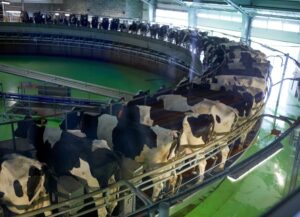Joaquín Ventura & Fernando Díaz
Multi-dose automatic syringes are used in bovine tuberculosis eradication campaigns for inoculating intradermal injections of purified protein derivatives (tuberculin). One of these is the McLintock syringe, which is widely used in Europe. It allows the intradermal injection of 0.1 mL of tuberculin in each inoculation, with a short needle that ensures that the tuberculin injection is intradermal.
Recommendations of general maintenance of the McLintock syringe include continuous revision of the needle (and replace if necessary), replacement of the seals annually, and periodic lubrication. In addition, disinfection of the device is essential because the same needle is used for several cows. This is probably a possible cause of cross infections and reactions that may complicate test interpretation.
The objective of a study carried out in Spain was to elucidate if McLintock syringes may cause skin reactions that can be interpreted as false-positive of tuberculosis. The researchers used 44 males cross-breed bulls (6-16 month-old) randomly selected from a tuberculosis-free herd with no history of infection during 10 years.
Every animal was inoculated four times (two on every side of the neck) with four different multi-dose automatic syringes: three McLintock (MPBS1, MPBS2 and MPPD) and one Dermojet (DPBS). Syringes MPBS1, MPBS2 and DPBS contained sterile phosphate buffer saline with 10% glycerol, and only the MPPD MacLintock syringe contained tuberculin.
Following the recommendations of the Royal Decree 2611/1996 that regulates the bovine tuberculosis test in Spain, the thickness of the skin in the inoculation sites were measured when animals were inoculated, repeating the reading 72 h after the injection. The interpretation for the intradermal tuberculin test was as follow:
- Positive reactor: when the increase in skin fold thickness is equal or greater than 4 mm and/or presence of clinical signs (presence of edema, exudate, necrosis, pain and regional lymphadenopathies).
- Inconclusive reactor: increase in skin fold thickness is greater than 2 mm and lower than 4 mm in the absence of clinical signs.
- Negative reactor: increase in skin fold thickness is equal or lower than 2 mm in the absence of clinical signs.
The researchers Roy et al. (2019) reported the following observations:
- The authors did not observe positive reactions in any of the inoculation sites, except one test using the Dermojet DPBS syringe that led to a reading of 3 mm. That could be interpreted as inconclusive or positive depending of the interpretation criteria.
- Neither inconclusive nor positive reactions were observed when McLintock syringes were used.
- No severe local reactions or regional lymphadenopathies were observed in any animal.
- Interestingly, the study showed a significant effect of the inoculation side in the increase of skin fold thickness. On average, inoculations in the neck left side were 0.35 mm greater than inoculations in the right side.
As no positive reactions were detected, this study demonstrated that using McLintock syringes did not cause false-positive tuberculosis reactions, at least under this experiment conditions. However, it is necessary to remember the importance of proper disinfection, maintenance, and cleaning of the syringes.
Reference
Roy A., Díez-Guerrier A., Ortega J., de la Cruz M.L., Sáez J.L., Domínguez L., de Juan L., Álvarez J., Bezos J. 2019. Evaluation of the McLintock syringe as a cause of non-specific reactions in the intradermal tuberculin test used for the diagnosis of bovine tuberculosis. Research in Veterinary Science. 122: 175–178.
© 2019 Dairy Knowledge Center, LLC. All Rights Reserved.









